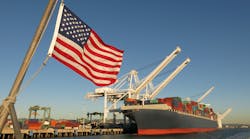by Laura Davison and Isabel Gottlieb
The U.S. is giving American exporters a sizable tax break on the goods and services they sell overseas. But the benefit might not be enough to convince Corporate America to expand its U.S. operations beyond what it was already planning.
Instead, the deduction may be going to companies that were already going to export with or without the tax incentive, such as airlines that fly internationally, including United Continental Holdings Inc., and defense contractors like Boeing Co. and Lockheed Martin Corp.
The provision was included in the Republican tax overhaul as a way to prod companies to move along the path President Donald Trump promised in his campaign -- to hire more people in the U.S., expand their manufacturing capabilities and store more of their intellectual property domestically. Yet so far, the tax break hasn't spurred a mass migration back the U.S., tax advisers say.
This tax break "isn't a driving reason for a company to start moving people or boxes,"' said Connie Cheng Cunningham, a tax managing director at the accounting firm BDO.
The write-off, known as the deduction for foreign-derived intangible income or FDII, drops the tax rate on income companies earn from goods and services made in the U.S. and sold overseas to about 13% from 21%. The Internal Revenue Service released regulations Monday detailing how companies can qualify for the tax break.
Despite the possibility of even lower taxes, many companies have been shifting jobs and operations out of the country. Harley Davidson and General Motors Co. have opted to move some operations offshore citing other business reasons, including lower labor costs, the U.S.-China trade conflict and being closer to their ultimate customers.
If it is consistent with their business operations companies are going to do "whatever they can to get it," said Derek Schraw, a partner at accounting firm Deloitte Tax. Some companies are still weighing whether they want to restructure in order to qualify for the tax break, he said.
Part of some companies' hesitation is that the benefit becomes less generous over time. The 13% levy is just an introductory teaser rate through 2025. After that, the deduction becomes less valuable, resulting in an ultimate tax rate of about 16% on exports.
The deduction could also disappear completely if members of the World Trade Organization challenge the measure as an illegal export subsidy that would require the U.S. to repeal or modify the deduction.
"There is still a concern that WTO foreign trading partners will continue to challenge FDII as an illegal export subsidy," said Larry LeBlanc, a partner at accounting firm RSM.
Such a challenge would likely take years to resolve, and any repeal is not likely to be retroactive, so companies can expect the benefit in the interim.
Exports have increased since the law was signed, but so have imports, likely a sign of a relatively strong economy, rather than a surge tied to a new tax break.
Total exports of goods and services increased about 3.7% in a year – from about $202.3 billion in November 2017 to about $209.9 billion in November 2018, the latest month for which data was available, according to the U.S. Census Bureau and the U.S. Bureau of Economic Analysis. But imports also increased about 3.2% in the same period, from about $251.2 billion in November 2017 to about $259.2 billion in November 2018, according to the same data.
The IRS rules also take a relatively lax approach to qualifying for the deduction, which could bolster interest in FDII. Individuals can claim the tax break if they want and the rules give companies an array of options to document that they are selling to a foreign party that makes them eligible for the break.
"Companies are not necessarily changing their whole mode of operation to take advantage of it," Schraw said. "If companies are going to move their intellectual property, people or business, it's going to be for business considerations as opposed to tax purposes."




